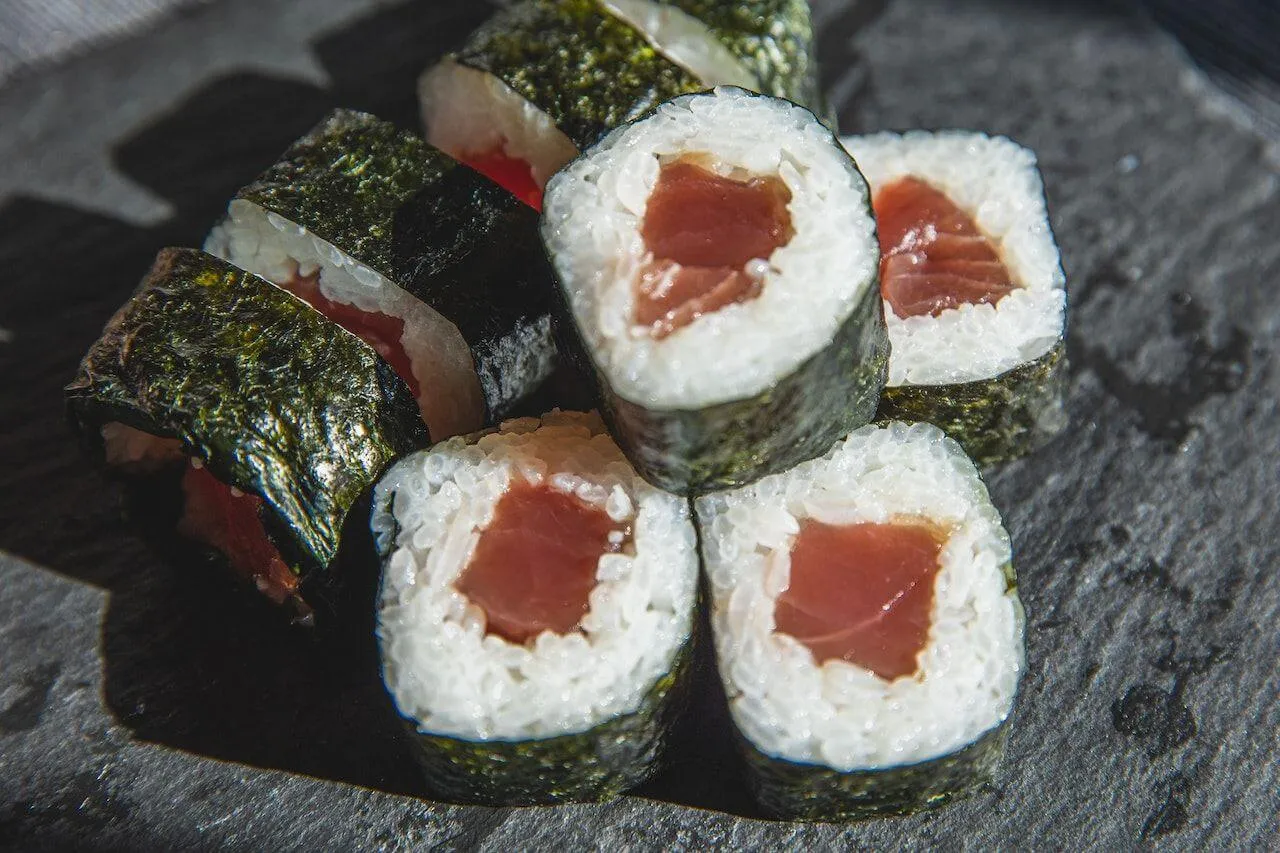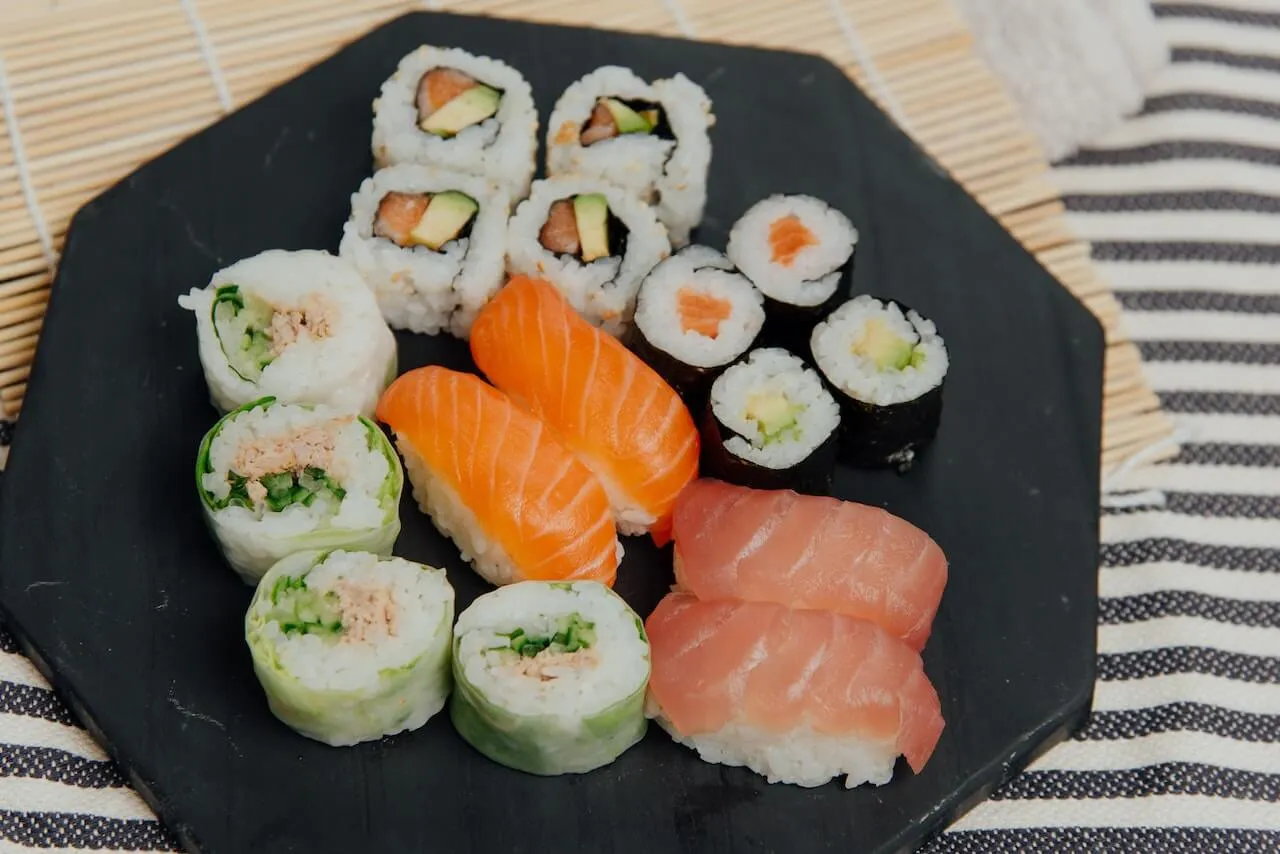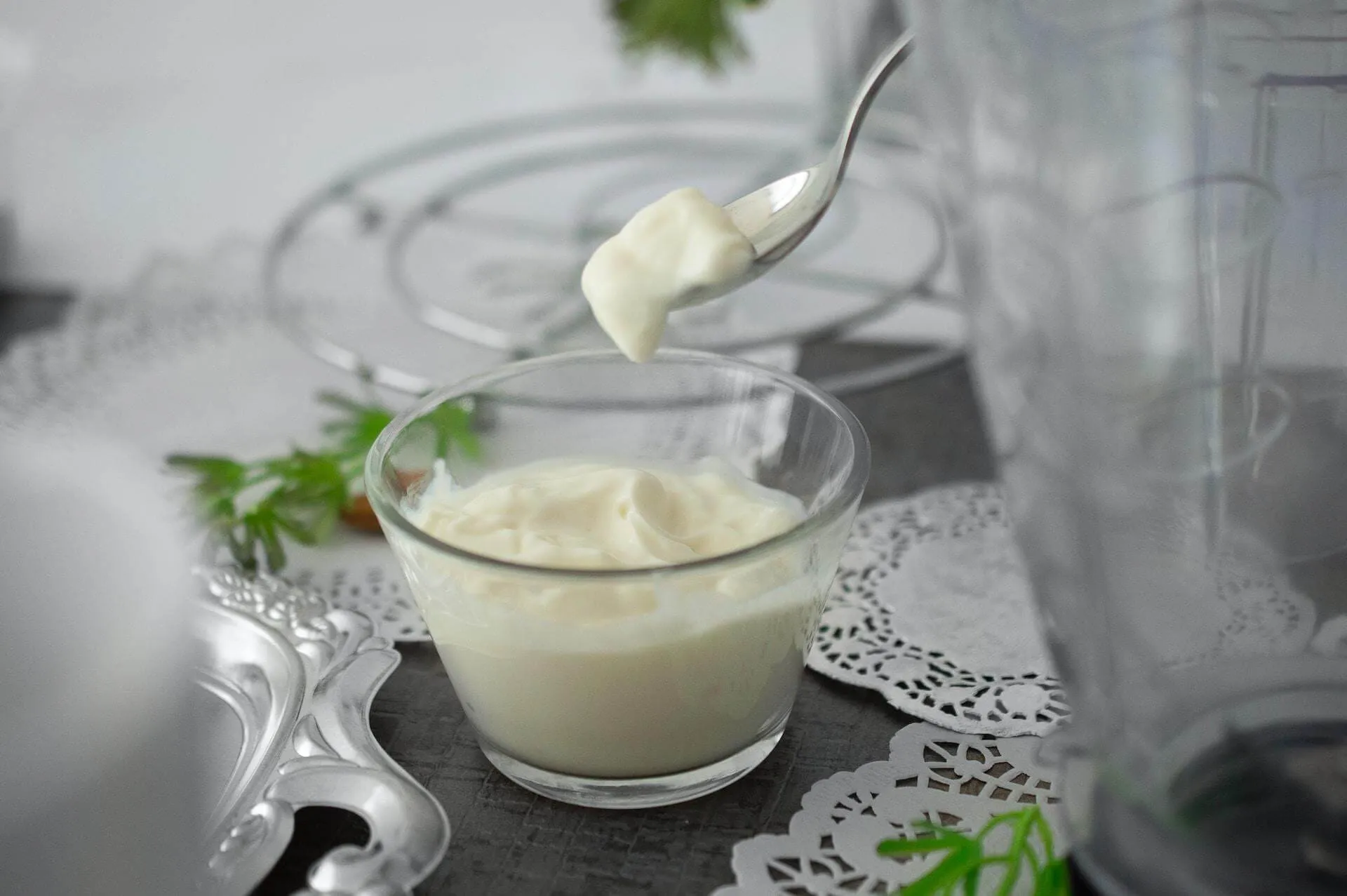Sushi is generally thought to be a healthy and nutritious meal. Sushi usually contains rice, vegetables, and fish, all of which together provide a balanced meal of carbs, protein, and fat.
Depending on what you order – either single bites of fresh and flavorful fish atop rice known as nigiri or specialty rolls made with a plethora of ingredients, from spicy tuna to shrimp tempura to cream cheese – your meal will be very different nutritionally.
Keep reading to learn more about the different types of sushi, potential health benefits, and potential risks.
What is Sushi, Exactly?
Sushi is a collection of rice, vegetables, and cooked or raw fish wrapped in a seaweed roll. Nigiri, sashimi, maki, and temaki are common types of sushi.
Sashimi is simply a piece of thinly sliced raw fish or meat. Nigiri, maki, and tamaki all include rice. The rice is prepared with vinegar and other seasonings to help hold its shape. Sushi comes in different forms, including:
- Maki - rolls with rice and different fillings (usually a vegetable or seafood) wrapped in seaweed
- Uramaki - sometimes called a “rebel roll,” Uramaki means inside out, so the seaweed is inside the roll and the rice is on the outside
- Nigri - rice topped with raw fish
- Temaki - a hand roll where seaweed is used as a wrap and filled with rice, fish, and vegetables
While sushi has many nutritious elements, the ingredients used in preparation determine the overall nutrition.1
Sushi Nutrition Facts
The nutrient profile of sushi depends on what you order and the ingredients used to prepare the dish. Generally, a meal that includes sushi can be a great way to load up on healthy fats (like omega-3 fatty acids), high-quality protein, selenium, and many other key nutrients.
Generally, one piece of a traditional maki roll provides between 20 and 28 calories. Depending on the filling, a piece of vegetable maki (20g), for instance, has 20 calories, while a piece of tuna maki (30g) has 29 calories. A piece of salmon nigiri (35g) provides 37 calories, and a slice (1 oz) of salmon sashimi provides 36 calories.
The glycemic index (GI) is a rating system for foods containing carbohydrates. It shows how quickly each food affects your blood sugar (glucose) level when eaten independently.
It’s hard to say the exact glycemic index (GI) of sushi because the amount of rice and other ingredients in sushi varies by type.
While white rice has a high GI score of 80 when consumed by itself, sushi is a combination of different foods in one dish, so assigning it a GI score isn’t necessarily accurate or helpful.
{{mid-cta}}
Is Sushi High in Carbs?
If you are hesitant to eat sushi for fear of eating too many carbs, rest assured that sushi and white rice are fine to include as part of a balanced diet. White rice is a great source of carbohydrates and provides a boost of short-term energy. Rice is often fortified with folic acid and B vitamins, too.
Eating white rice by itself can cause spikes in blood sugar, often leading to a drastic drop afterward. However, you don’t need to worry about significant shifts in blood sugar when you’re eating sushi because the rice is paired with high-quality protein and healthy fats. Adding protein and fat to carbohydrates slows digestion and helps keep blood sugar levels stable.
So while sushi is high in carbs, it’s also providing your body with protein and dietary fat.
Health Benefits of Sushi
It’s made with nutrient-rich ingredients
Sushi can be made with many nutrient-rich ingredients. Fish, wasabi, seaweed, and ginger are nutritious ingredients commonly used in sushi.
Fish
Fish is an excellent source of protein, iodine, and multiple vitamins and minerals. Additionally, it’s one of the few foods that naturally contain vitamin D.2
Fish is also high in omega-3 fatty acids, which your brain and body need to function optimally. These fats help decrease the risk of certain medical conditions like heart disease and stroke. Some studies suggest that omega-3s may also help fight autoimmune diseases, depression, and loss of memory and vision in old age.3
Ginger
Another ingredient that accompanies sushi is pickled ginger or gari. This is provided as a garnish to cleanse your palate between rolls. Ginger is a good source of potassium, magnesium, copper, and manganese. It may also have certain properties that help protect against bacteria and viruses.
Some research suggests that ginger is a natural remedy for nausea and may help with muscle pain, arthritic pain, and menstrual pain. It may also help lower LDL cholesterol.
Wasabi
Wasabi is made from the grated stem of Eutrema japonicum, a plant from the cabbage, horseradish, and mustard family. It is a good source of beta-carotene, glucosinolates, and isothiocyanates. Studies show that these plant compounds may provide antibacterial, anti-inflammatory, and anticancer benefits.4
Seaweed
Seaweed is rich in antioxidants, vitamins, minerals, and protective pigments. It contains small amounts of vitamins A, C, E, and K and folate, zinc, sodium, calcium, and magnesium. It is also a source of iodine, a trace mineral important for the health and function of the thyroid.5

May promote gut health
Fermented foods often accompanying sushi, like seaweed, ginger, kimchi, and tofu, may promote gut health and healthy digestion. Research suggests that these foods support the healthy growth of millions of bacteria, viruses, and fungi in the digestive tract.6
May boost the immune system
Studies have shown that the same fermented foods that may promote gut health might also reduce inflammation.6
Chronic inflammation is often associated with health problems like arthritis and Type 2 diabetes. Studies show that eating a diet rich in fermented foods can reduce inflammatory proteins in the body.
It’s rich in heart and brain-friendly fatty acids
Salmon and mackerel are excellent sources of protein in addition to DHA omega-3 fatty acids. Some research suggests that consuming omega-3s might result in a reduced risk of coronary heart disease.7
Good source of iron
Seaweed is a good source of iron. The body uses iron to make hemoglobin, a protein found in red blood cells that carries oxygen from the lungs to all parts of the body, and myoglobin, a protein that provides oxygen to muscles.
Helps thyroid functioning
Seaweed is one of the best sources of iodine. The thyroid gland needs iodine to make hormones that play an important role in metabolism, cell repair, and other vital bodily functions.
According to one study published in the Journal of Food and Drug Analyses, there are 30 to 40 mcg of iodine in just one gram of seaweed. This is about a quarter of the recommended daily intake.8
Is Sushi Safe for Everyone? 4 Potential Risks
While sushi is safe for most individuals to consume, there are some reasons why certain people might want to avoid or limit their intake.
May lead to high sodium intake
One of the things that makes sushi so delicious is its high sodium content. Salt is added to most of the ingredients used to prepare sushi, and that’s before you add soy sauce as a dipping sauce.
While occasional high sodium intake isn’t an issue for most healthy individuals, it may pose a risk for people with high blood pressure or heart disease. Eating too much salt too frequently may contribute to an increased risk of heart disease.9
It’s high in refined carbs and low in fiber
Sushi is usually made with white rice, a refined carbohydrate low in fiber.
Some research suggested that excess consumption of refined carbs has contributed to the prevalence of type 2 diabetes in the United States. The high sugar content of white rice may contribute to spikes in blood sugar; however, when white rice is eaten with other foods that provide protein and fat, this is generally not a concern.
Although sushi is high in refined carbs and has little fiber, it’s still okay to enjoy this delicious meal as part of a balanced diet.
May increase levels of mercury
Some fish contain high levels of mercury. Some fish that are commonly high in mercury are King mackerel, marlin, orange roughy, shark, swordfish, tilefish, ahi tuna, and bigeye tuna.
Consuming mercury-containing fish in moderation likely won’t harm you; however, if you want to avoid fish that are higher in mercury, opt for shellfish like eel, salmon, crab, and clams.11
Possible contamination with bacteria and parasites
The way foods are prepared has a significant impact on health and food safety. Cooking foods at high heat kills pathogens that can cause foodborne illness. Most sushi is served with raw fish, so there can be a risk of exposure to bacteria and parasites that can make you very ill.
The biggest risk of consuming uncooked, undercooked, or frozen seafood is parasites. The U.S. Department of Health & Human Services recommends cooking food thoroughly before consuming it for people with a weakened immune system, pregnant women, and older adults. This includes avoiding raw fish.12
Should You Be Concerned About Mercury Levels?
When mercury levels become too high, it can harm brain function and heart health.
Some research has linked exposure to heavy metals to conditions like Alzheimer’s, Parkinson’s, autism, depression, and anxiety.13
Mercury exposure may also be related to high blood pressure, a higher risk of heart attacks, and elevated LDL cholesterol levels.
Mercury levels are measured in parts per million (ppm). The following is a list of the mercury levels found in fish from highest to lowest:
Swordfish: 0.995 ppm
Shark: 0.979 ppm
King mackerel: 0.730 ppm
Bigeye tuna: 0.689 ppm
Marlin: 0.485 ppm
Canned tuna: 0.128 ppm
Cod: 0.111 ppm
American lobster: 0.107 ppm
Whitefish: 0.089 ppm
Herring: 0.084 ppm
Hake: 0.079 ppm
Trout: 0.071 ppm
Scallops: 0.003 ppm
Crab: 0.065 ppm
Haddock: 0.055 ppm
Whiting: 0.051 ppm
Atlantic mackerel: 0.050 ppm
Crayfish: 0.035 ppm
Pollock: 0.031 ppm
Catfish: 0.025 ppm
Squid: 0.023 ppm
Salmon: 0.022 ppm
Anchovies: 0.017 ppm
Sardines: 0.013 ppm
Oysters: 0.012 ppm
Shrimp: 0.001 ppm
The nutritional health benefits of eating fish may outweigh these risks as long as you limit your intake of high-mercury fish.14
What Sushi Ingredients Are Healthy?
There are many ingredients found in sushi that provide nutritional benefits. Some nutrient-dense ingredients in sushi include cucumber, seaweed, ginger, fish, and avocado.
Avocados are an excellent source of heart-healthy fats and vitamin E.
Seaweed is a classic ingredient in sushi, both as dried sheets used to wrap around the rice (nori) or in salads (wakame). Seaweed is also a good source of fiber, protein, vitamins, and minerals, including iodine, iron, zinc, and vitamin B12.
Best Sushi For Your Health
Vegetarian and veggie rolls
Vegetarian and veggie rolls are low in saturated fat and provide many vitamins and minerals.
Alaska roll
The filling of Alaska rolls includes crab, avocado, cucumber, and some other ingredients tightly rolled by a layer of dried seaweed. It’s a great choice because it contains protein and healthy fats, which are important for maintaining energy levels and fueling your body.
Salmon and avocado roll
Salmon is a rich source of many nutrients, including protein, healthy fats, selenium, and vitamin B12, while avocado provides fiber, magnesium, vitamin C, vitamin E, and folate.
Tuna roll
The omega-3 fatty acids in tuna provide many benefits for the body, including lowering cholesterol, supporting brain health, and improving heart health.
California roll
California rolls contain a combination of cucumber, crab, and avocado. They provide a healthy balance of carbs, fiber, and healthy fats all rolled up together.
Rainbow roll
Rainbow rolls are high in protein and healthy fats. They also provide vitamins and minerals from different sources of seafood, vegetables, and sometimes fruit.
What Sushi Ingredients Should You Limit?
Sushi rice is usually made with a combination of vinegar, sugar, and salt. The sugar added to the rice increases the calories of the meal without much thought. The added salt will also contribute to your daily sodium intake.
Soy sauce is high in salt, so if you’re watching your sodium intake, be mindful of how much you use.
Some varieties of sushi are made with mayonnaise and cream cheese or are deep-fried in batter. This can significantly increase the amount of saturated fat in your meal.
Sushi Rolls to Look Out For

Philadelphia roll
Philadelphia rolls are made with cream cheese, which is high in saturated fat and cholesterol. If it’s the only roll you’re eating in the meal and you’re pairing it with another item that is high in protein and fiber, consuming this roll is probably not a big deal. However, if you’re eating it with several other rolls, you may want to skip this one.
Shrimp tempura
Tempura shrimp is battered and deep-fried. Although shrimp is a good source of protein, consuming too much fried food can harm your health. Tempura shrimp are also typically covered in a sauce made with mayo and sugar. Shrimp tempura rolls are best enjoyed every once in a while.
Swordfish, shark, and marlin
Swordfish, shark, and marlin are often served as sashimi or nigiri. While these fish are an excellent source of protein, these specific species are on the FDA's list of fish that small children and women who are pregnant, may become pregnant, or are breastfeeding, should avoid because of potentially high levels of mercury.
Dragon Roll
Dragon rolls are made with several ingredients and usually have shrimp tempura and sauces made with mayo and sugar. This roll is high in saturated fat and sugar, which can increase the calorie density of your meal.
A Peek Into An Ideal Healthy Sushi Meal
A healthy sushi meal could include:
Six pieces of salmon roll: ~185 calories
Six pieces of avocado roll: ~166 calories
Six pieces of California roll: ~167 calories
If you feel hungrier than usual, you may want to order a side salad, miso soup, and edamame. If your appetite is smaller, but you still want miso soup and edamame, you might order two sushi rolls instead of three.
If you eat sushi often, stick to basic rolls (without tempura and sauces) and order some nutritious, healthy sides. If you don’t eat sushi often, you should order whatever sounds good at the time.
Sushi vs. Weight Loss: Can They Go Together?
Any food can be a part of your diet if you're trying to lose weight. Balance is the key to sustainable weight loss.
Ordering sashimi, nigiri, and simple rolls will help lower your meal's calorie content. Eat mindfully to prevent overeating. Eat slowly, savor every bite, and stop when you’re full.
5 Tips to Make a Healthy Sushi Order
Try cone-shaped hand rolls
To decrease carbohydrate intake, order some tamaki. Tamaki contains less rice than other traditional rolls.

Add more protein and fiber to your meal
Order edamame, wakame salad, miso soup, or sashimi with your sushi.
Limit rolls made with cream cheese, sauces, or tempura
To create crunchiness without these ingredients, ask for extra vegetables.
Use less soy sauce or ask for low-sodium soy sauce
If you are salt-sensitive, avoid soy sauce or only lightly dip your sushi in it.
Order sushi from reputable restaurants
Eat sushi at reputable restaurants that are more likely to follow proper food safety practices. You can also opt for vegetarian rolls or ones made with cooked fish.
Final Verdict: Is Sushi Healthy?
Sushi is a collection of rice, vegetables, and cooked or raw fish wrapped in a seaweed roll. Nigiri, sashimi, maki, and temaki are common types of sushi.
Sushi has a ton of vitamins, minerals, and health-promoting ingredients. Some types of sushi are high in refined carbs, salt, and saturated fats.
If you’re mindful about what you order, sushi can make a great addition to a balanced diet.
Using a CGM with Signos: Real-Time Data, Backed by AI
Signos pairs a real-time glucose biosensor with AI trained on tens of millions of data points to deliver personalized, science-backed guidance for weight management and health. See exactly how your body responds, and take action.
Learn how it works. Ready to get started? Join now.
Topics discussed in this article:
References
- Hsin-I Feng, C. (2012). The tale of sushi: History and regulations. Comprehensive Reviews in Food Science and Food Safety, 11(2), 205–220. https://doi.org/10.1111/j.1541-4337.2011.00180.x
- Lu Z, Chen TC, Zhang A, et al. An evaluation of the vitamin D3 content in fish: Is the vitamin D content adequate to satisfy the dietary requirement for vitamin D? J Steroid Biochem Mol Biol. 2007;103(3-5):642-644. doi:10.1016/j.jsbmb.2006.12.010
- Grosso G, Galvano F, Marventano S, et al. Omega-3 fatty acids and depression: scientific evidence and biological mechanisms. Oxid Med Cell Longev. 2014;2014:313570. doi:10.1155/2014/313570
- Kinae N, Masuda H, Shin IS, Furugori M, Shimoi K. Functional properties of wasabi and horseradish. Biofactors. 2000;13(1-4):265-269. doi:10.1002/biof.5520130140
- Fooddata Central Search Results. FoodData Central. https://fdc.nal.usda.gov/fdc-app.html#/food-details/170495/nutrients. Accessed December 30, 2022.
- Wastyk HC, Fragiadakis GK, Perelman D, et al. Gut-microbiota-targeted diets modulate human immune status. Cell. 2021;184(16):4137-4153.e14. doi:10.1016/j.cell.2021.06.019
- Office of Dietary Supplements. Omega-3 fatty acids. National Institutes of Health. https://ods.od.nih.gov/factsheets/Omega3FattyAcids-HealthProfessional/
- Journal of Food and Drug Analysis. Analysis of iodine content in seaweed by GC-ECD and estimation of iodine intake. 2014;22(2):189-196. doi:10.1016/j.jfda.2014.01.014
- Food and Drug Administration. Sodium in Your Diet. https://www.fda.gov/food/nutrition-education-resources-materials/sodium-your-diet
- Ludwig DS, Majzoub JA, Al-Zahrani A, Dallal GE, Blanco I, Roberts SB. High glycemic index foods, overeating, and obesity. Pediatrics. 1999;103(3):e26-e26. doi:10.1542/peds.103.3.e26
- Food and Drug Administration. Advice about Fish Eating. https://www.fda.gov/food/consumers/advice-about-eating-fish#text
- FoodSafety.gov. People are at risk of food poisoning. https://www.foodsafety.gov/people-at-risk
- Zahir F, Rizwi SJ, Haq SK, Khan RH. Low dose mercury toxicity and human health. Environ Toxicol Pharmacol. 2005;20(2):351-360. doi:10.1016/j.etap.2005.03.007
- Mozaffarian D, Shi P, Morris JS, et al. Mercury exposure and risk of cardiovascular disease in two U.S. cohorts. N Engl J Med. 2011;364(12):1116-1125. doi:10.1056/NEJMoa1006876
- Food and Drug Administration. Mercury Levels in Commercial Fish and Shellfish (1990-2012). https://www.fda.gov/food/environmental-contaminants-food/mercury-levels-commercial-fish-and-shellfish-1990-2012




.svg)










.svg)
.svg)
.svg)
.svg)
.svg)
.svg)
.svg)
